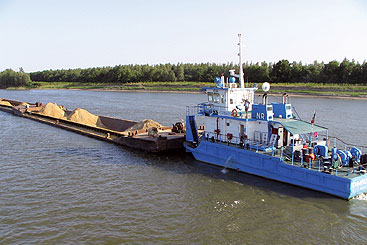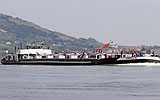
PLATINA project under full sail
After its launch in June 2008, the Platform for the Implementation of NAIADES is currently under way, working to support and promote the competitive position of inland waterway transport in Europe.

More than 37,000 kilometres of waterways connect hundreds of cities and industrial regions.
Inland waterway transport is an environmentally friendly alternative to road or rail transport, in terms of both energy consumption and noise and gas emissions. In addition, inland waterway transport ensures a high degree of safety to the transportation of goods, and it contributes to the decongestion of the overloaded road network in densely populated regions. on the other hand, not every river section is suitable to all waterway transport interests.
The European Commission is using the Platform for the Implementation of NAIADES (PLATINA) to promote and support its European Action Programme for Inland Waterway Transport (2006– 2013). Funded by the 7th Framework Programme for Research and Technology Development, the PLATINA project is executed by a consortium of 22 public and private key stakeholders, including the ICPDR. The core consortium is formed by via donau (Austria) as coordinator and host of the Technical Secretariat, Voies navigables de France (France), Bundesverband der Deutschen Binnenschiffahrt (Germany), Promotie Binnenvaart Vlaanderen (Belgium) and the Rijkswaterstaat Centre for Transport and Navigation (The Netherlands).
At the official kick-off event on 1 October 2008 in Brussels, Astrid Schlewing from the European Commission’s Directorate General for Energy and Transport highlighted the benefits of inland waterway transport and its role within the EU transport policy. “The European Parliament and the Council of Ministers have welcomed the initiative and endorsed the programme; the industry has also confirmed its broad consent,” said Schlewing. “This is the first time the EC has presented a comprehensive action plan for the inland waterway transport mode.”
There is a clear need to reconcile transport policy objectives with the interests of other water users, such as environment and nature, flood protection, recreation, energy and other land uses. The PLATINA project aims to ensure the proper integration of environmental aspects in the development and maintenance of inland waterway infrastructure, in line with the targets of the EU Water Framework Directive. The ICPDR has taken a leading role in combining these objectives.
sTRaTegIc aReas foR PlaTINa
PLATTINA will provide technical, organisational and financial support for targeted policy actions in five strategic areas that require action: markets, fleet, jobs and skills, image and
infrastructure.
Markets
Inland navigation faces several difficulties in achieving a higher share of the growing transport markets. This includes a limited awareness of its real opportunities for potential customers and administrative and regulatory barriers complicating the establishment of new services and market initiatives. PLATINA will develop coordinated electronic information services about modern IWT and support improving the framework conditions for entrepreneurs.
Fleet
Ship size, modernisation and innovation, such as logistics concepts or environmental and safety standards, considerably influence the efficiency and thus competitiveness of navigation. Substantial parts of the fleet still need further improvement, and an international hull database needs to be built up among other things, to set up an international traffic information service.
Jobs and skills
The lack of skilled labour poses a major problem to the future development of inland navigation in Europe. Highly qualified personnel are crucial for the efficient operation and competitiveness. In almost all Member States, national job profiles are under reform; harmonising job profiles is currently being discussed throughout Europe, in the framework of river commissions as well. This will enable employers and crew members to be more flexible in the European job market.
In June 2008 a European network of inland navigation schools, EDINNA, was founded. PLATINA will provide organisational support, such as harmonising training curricula and providing up-to-date learning content and tools. A new recruitment strategy and campaign at a European-wide level will promote job and career opportunities in the IWT sector.
Image
Cooperation and coordination between the public and the private sector is needed to effectively develop inland navigation as an essential element in Europe’s freight transport system. Inland navigation promotion and development centres, such as those in the Netherlands, Belgium, France and Austria, are important knowledge pools and interfaces between shippers, the IWT sector and political decision makers. PLATINA will extend this network to further countries, organise regular events and raise awareness about IWT.
Infrastructure
The European inland waterway network, particularly on the Danube, is not utilised to its full potential. Its full capacity is hampered by various bottlenecks, such as limited fairway depths, bridge clearances or lock dimensions. During the period 2007–2013, approximately €610 million (11.5% of the total TEN-T budget) is allocated to inland waterways (Priority Project 18 Main– Danube and 30 Seine–Scheldt connections). The ongoing revision of the TEN-T Guidelines requires input on funding needs and priority projects until 2025 within a new European IWT Infrastructure Development Plan, containing an up-to-date inventory of the bottlenecks and missing links of the European waterway network.
One way to support traffic and transport management in inland navigation is through River Information Services (RIS). The related EU Directive 2005/44/EC sets a basis for implementing RIS (e.g. binding rules for data communication and RIS equipment, minimum level of such services), which PLATINA will support at administrative and technical levels. Implementation of RIS will lead to an increased competitiveness and improved safety of inland navigation.
PLATINA funding guide
On 1 October 2008 PLATINA presented its first publication, a Funding Guide for Inland Waterway Transport. The user-friendly guide offers detailed information about funding programmes and financial aid schemes available for the inland navigation sector at EU, national and regional levels. The guide is available online and in print form in English, Dutch, French and German.
Integrated stakeholder dialogue. In 2007, the ICPDR, together with the Danube Navigation Commission and the International Sava River Basin Commission, initiated an intense cross-sectoral discussion process. This discussion resulted in the “Joint Statement on
Guiding Principles for the Development of Inland Navigation and Environmental Protection in the Danube River Basin”. These general planning guidelines and criteria take into account both ecological and navigation interests, and the PLATINA project will offer three follow-up steps:

Inland waterway transport plays an important role for the transport of goods in Europe.
Integrative study on hydro-morphological alterations of the Danube. With hydro-power, navigation is one of the key drivers causing hydro-morphological alterations to rivers with significant impact on river ecology. The Vienna University of Natural Resources and Applied Life Sciences (BoKu) has just completed a scientific assessment began last year. This analysis uses relevant reference studies and local river data, such as new ICPDR data from the 2007 Joint Danube Survey 2, about hydro-morphology along the Upper, Middle and Lower Danube. The study also addresses future pressures from inland navigation, and the results and methods will be applicable outside the Danube Basin as well.
Best practices in sustainable waterway planning. Future waterway projects can also make use of the Joint Statement’s planning guidelines, which fully integrates the objectives of EU requirements for water and nature protection, such as the EU Water Framework Directive, and the Birds and Habitat Directives. In a new manual, examples of best practices in planning and implementing IWT projects on the Danube and other rivers demonstrate how this can be achieved on the Danube and other rivers. This manual, prepared by the ICPDR with the support of via donau and BoKu, can serve as a reference for inland waterway planning authorities and relevant stakeholders. Philip Weller, ICPDR Executive Secretary underlines that the manual will “not only address the experts in charge of infrastructure planning, maintenance and development, but also other indirectly concerned parties. The scope of the manual will therefore not be too technical.”
Training and information dissemination. The ICPDR will arrange an extensive international exchange of experience in the field of infrastructure development, thus disseminating modern know-how and increasing the planning security of individual IWT projects. Three training workshops for inland waterway planning officials and relevant stakeholders will be organised – two in 2009, and the last in 2011. The ICPDR has developed a seminar concept that will present international experience and example cases and discuss the draft manual, with support to come from Inland Navigation Europe and via donau. “With this package we want to achieve the reconciliation of navigation and ecology also at the practical level. We are convinced that this is the only way to succeed with IWT projects,” says Weller.
For more information on the European transport policy, and news from the IWT sector and the PLATINA project, please visit www.naiades.info
Disclaimer
The information contained in the ICPDR website is intended to enhance public access to information about the ICPDR and the Danube River. The information is correct to the best of the knowledge of the ICPDR Secretariat. If errors are brought to our attention we will try to correct them.
The ICPDR, expert group members, nor other parties involved in preparation of information contained on this website cannot, however, be held responsible for the correctness and validity of the data and information provided, nor accept responsibility or liability for damages or losses arising directly or indirectly from the use of the information conveyed therein.
Only those documents clearly marked ICPDR documents reflect the position of the ICPDR.
Any links to other websites are provided for your convenience only. The ICPDR does not accept any responsibility for the accuracy, availability, or appropriateness to the user's purposes, of any information or services on any other website.
When using the information and material provided on this website, credit should be given to the ICPDR.
